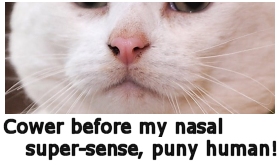The wonderful world of smell
Even smells like roses is not what they supposes
And goodness only knowses, the noselessness of man
G.K. Chesterton

Cats have a very acute sense of smell. Although cats may compare unfavourably with dogs in olfactory ability, a cats' sense of smell is nevertheless so far beyond anything humans can approach that it literally adds an extra dimension to their world.
So what apparatus does the cat use to achieve this superior level of smelling ability? Let's begin by looking at a cat's nasal cavities, which are filled with a number of bony plates called turbinals. These turbinals are covered with layers of tissue holding huge numbers of olfactory cells. Olfactory cells are so-called 'sensory cells' which means that they transmit signals to the brain. With olfactory cells the signals transmit the sensory stimuli caused by odour. A good way to think of these cells is as nerve fibres that transmit impressions of smell in much the same way as other cells transmit a sense of touch and feel.
The number and shape of turbinals in the feline nasal cavity means that a large surface area is available to pick up any hint of an odour that finds its way there. Here's how the numbers stack up. We humans have somewhere between five and 20 million olfactory cells in our noses - a cat has about 67 million. So an average cat has about five times your collection of olfactory cells. As you can imagine, with that enhanced ability, a cat is exposed to an array of smells which we have no idea exist - and it still sleeps in the laundry hamper with your used socks. They are tough creatures.
But olfactory overkill in the nasal department is only half the story.. Cats have an additional scent organ, independent of their noses and totally lacking in humans. Meet the vomeronasal, or Jacobson's organ. This organ sits well forward on the roof of a cat's mouth. Unlike the olfactory cells, the vomeronasal organ transmits the scent following direct contact.
You may have seen your cat wrinkling its muzzle, and lowering its chin in a manner which referred to as 'flehmening' (from the German verb 'flehmen' which means to bare the upper teeth). When it does this, the cat is opening the passage to the vomeronasal organ to allow the transfer of pheromones and other scents. Air inhaled during flehmening brings the maximum number of scent particles into the vomeronasal organ. Information about the scent is then transmitted to the the area of the brain called the hypothalamus. This is a different area of the brain to that which receives signals from the nose via olfactory nerves. The vomeronasal organ sends its signal to the area of the hypothalamus which triggers complex patterns of sexual behaviour and hunger for food.
Even as the vomeronasal organ is doing its thing, other parts of the brain are processing the olfactory information from the nose. Once processed in the brain, all this data presents the cat with a detailed and complex picture of the world - one completely different from human perception. So it is perhaps not surprising that for example cats recognise each other - or us for that matter - more by smell than by sight. And this is true from the day the cat is born, because smell is almost certainly the first sense a kitten has at its disposal. This is why a kitten can recognise an individual nipple as it feeds from the mother. Observation shows each kitten claims one particular nipple and keeps to it. This allows each kitten to feed quickly without shoving and competing with siblings.
As they get older, cats develop a peculiar obsession with rubbing themselves against every bit of domestic furniture they can reach (and in this context humans count as domestic furniture). By rubbing against a surface, the cat marks it with her personal pheromone set. This individual scent the cat, and other cats, can read with ease. Smelling 'home' pheromones reassures the cat that she belongs in that environment, and tells other cats that the space has been claimed.
You may also have noticed that your cat may immediately clean her coat where you have petted her. Don't take it personally - while grooming that patch of fur afterwards your cat is reading an immense amount of olfactory information about you, where your hand has been, and even what mood you are in. Even a human is aware of the pungent aroma of a tomcat's urine. To another cat the wealth of scent is the equivalent of an entire Facebook page combined with medical record and diary. When a cat sprays urine on a surface, that cat is making a detailed personal statement to the world.
Some believe that cats ignore their own reflection in the mirror because they can't smell the cat they see, and therefore accept that the reflection is not 'real'. This explanation is not fully convincing since it is not uncommon for a cat to see its own reflection and then go behind the mirror to look for that 'other cat' that should be there. Nevertheless, the fact that the ‘other cat’ leaves no smell reassures the non-reflection that her personal space is not being intruded upon.
So in summary, for a cat the sense of smell is a very important interface connecting her to the world. Humans live in a transitory world where things swiftly move out of sight or fade from hearing. A cat's detailed and sophisticated sense of smell allows it to 'see' the past - where a mouse has run by, where someone laid flowers on a surface, which humans have recently been in a room and where they went.
When we consider that cats also have vastly superior night vision and a sense of hearing well beyond our own, that they also have this literally super-human sense of smell hardly seems fair.
